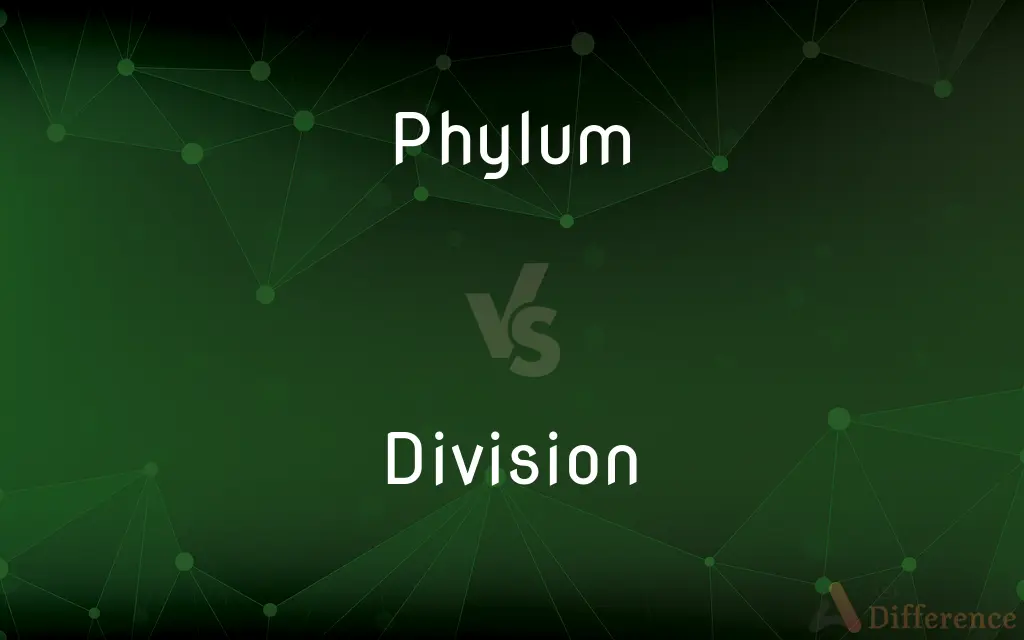Phylum vs. Division — What's the Difference?
By Tayyaba Rehman — Updated on September 21, 2023
Phylum is a major taxonomic rank in animal classification, while Division is its equivalent in plant and fungal classification.

Difference Between Phylum and Division
Table of Contents
ADVERTISEMENT
Key Differences
In biological taxonomy, both Phylum and Division are significant hierarchical categories that are used to classify organisms. Phylum is predominantly employed when classifying animals. For example, all vertebrate animals belong to the Phylum Chordata because they have a notochord. On the other hand, Division is the term used primarily in botany, the study of plants, and mycology, the study of fungi.
When scientists study and classify animals, they arrange them into various taxonomic levels like Kingdom, Phylum, Class, Order, and so on. The term Phylum holds prominence as it differentiates major groups based on specific structural and developmental characteristics. Division, in plants and fungi classification, serves a similar purpose as Phylum in animals. Plants are segregated based on features like reproduction and cellular structure.
Both Phylum and Division are positioned between Kingdom and Class in the taxonomic hierarchy. Though their function is essentially similar, their application is different, distinguishing between the animal kingdom and the realms of plants and fungi. It's noteworthy that some biologists might use "Division" even for some animal groups, but this is less common.
Despite the difference in application, both Phylum and Division play pivotal roles in understanding the evolutionary relationships among organisms. By grouping species into respective Phyla or Divisions, scientists can infer patterns of common ancestry and trace the path of evolution.
Comparison Chart
Kingdom Associated
Animalia
Plantae & Fungi
ADVERTISEMENT
Function
Classifies major animal groups
Classifies major plant and fungal groups
Position in Taxonomy
Between Kingdom and Class
Between Kingdom and Class
Based On
Structural and developmental characteristics
Reproduction and cellular structures
Example
Chordata (vertebrates)
Pteridophyta (ferns)
Compare with Definitions
Phylum
A hierarchical level in the taxonomic system used for classifying animals.
Starfish are classified under the Phylum Echinodermata.
Division
A primary taxonomic rank below Kingdom and above Class in plant and fungal classification.
Ferns belong to the Division Pteridophyta.
Phylum
A grouping of organisms based on structural and developmental similarities.
Worms in the Phylum Annelida have segmented bodies.
Division
A hierarchical level in the taxonomic system specifically for plants and fungi.
The Division Magnoliophyta includes flowering plants.
Phylum
A primary taxonomic rank below Kingdom and above Class in animal classification.
Humans belong to the Phylum Chordata.
Division
The action of separating something into parts or the process of being separated
A gene that helps regulate cell division
The division of the land into small fields
Phylum
A major category in the taxonomy of animals often used to indicate evolutionary lineage.
The Phylum Arthropoda includes insects, spiders, and crustaceans.
Division
Difference or disagreement between two or more groups, typically producing tension
A growing sense of division between north and south
Deep cultural divisions
Phylum
In biology, a phylum (; plural: phyla) is a level of classification or taxonomic rank below kingdom and above class. Traditionally, in botany the term division has been used instead of phylum, although the International Code of Nomenclature for algae, fungi, and plants accepts the terms as equivalent.
Division
The process of dividing one number by another
No multiplication or division is necessary
Phylum
A principal taxonomic category that ranks above class and below kingdom, equivalent to the division in botany.
Division
Each of the parts into which something is divided
The main divisions of the book
Phylum
A group of languages related to each other less closely than those forming a family, especially one in which the relationships are unclear.
Division
A partition
The villagers lived in a communal building and there were no solid divisions between neighbours
Phylum
(Biology) A taxonomic category of organisms ranking below a kingdom and above a class. In the classification of plants, division often replaces phylum.
Division
The act or process of dividing.
Phylum
(Linguistics) A large division of possibly genetically related families of languages or linguistic stocks.
Division
The state of having been divided.
Phylum
(taxonomy) A rank in the classification of organisms, below kingdom and above class; also called a divisio or a division, especially in describing plants; a taxon at that rank
Mammals belong to the phylum Chordata.
Division
(Mathematics) The operation of determining how many times one quantity is contained in another; the inverse of multiplication.
Phylum
(linguistics) A large division of possibly related languages, or a major language family which is not subordinate to another.
Division
The proportional distribution of a quantity or entity
The division of his property among his heirs.
Phylum
One of the larger divisions of the animal kingdom; a branch; a grand division.
Division
Something, such as a boundary or partition, that serves to divide or keep separate.
Phylum
A series of animals or plants genetically connected.
Division
One of the parts, sections, or groups into which something is divided.
Phylum
(linguistics) a large group of languages that are historically related
Division
An area of government or corporate activity organized as an administrative or functional unit.
Phylum
(biology) the major taxonomic group of animals and plants; contains classes
Division
A territorial section marked off for political or governmental purposes.
Phylum
An assemblage of organisms that share a unique set of characteristics.
Organisms in the Phylum Mollusca, like snails, have soft bodies.
Division
An administrative and tactical military unit that is smaller than a corps but is self-contained and equipped for prolonged combat activity.
Division
A group of several ships of similar type forming a tactical unit under a single command in the US Navy.
Division
A former unit of the US Air Force that was larger than a wing and smaller than an air force.
Division
(Botany) The taxonomic category ranking just below kingdom, consisting of one or more related classes, and corresponding approximately to a phylum in zoological classification.
Division
A category created for purposes of competition, as in boxing.
Division
Variance of opinion; disagreement.
Division
A splitting into factions; disunion.
Division
The physical separation and regrouping of members of a parliament according to their stand on an issue put to vote.
Division
(Biology) Cell division.
Division
A type of propagation characteristic of plants that spread by means of newly formed parts such as bulbs, suckers, or rhizomes.
Division
(uncountable) The act or process of dividing anything.
Division
Each of the separate parts of something resulting from division.
Division
The process of dividing a number by another.
Division
(arithmetic) A calculation that involves this process.
I've got ten divisions to do for my homework.
Division
(military) A formation, usually made up of two or three brigades.
Division
A usually high-level section of a large company or conglomerate.
Division
(taxonomy) A rank below kingdom and above class, particularly used of plants or fungi, also (particularly of animals) called a phylum; a taxon at that rank.
Magnolias belong to the division Magnoliophyta.
Division
A disagreement; a difference of viewpoint between two sides of an argument.
Division
(government) A method by which a legislature is separated into groups in order to take a better estimate of vote than a voice vote.
The House of Commons has voted to approve the third reading of the bill without a division. The bill will now progress to the House of Lords.
Division
(music) A florid instrumental variation of a melody in the 17th and 18th centuries, originally conceived as the dividing of each of a succession of long notes into several short ones.
Division
(music) A set of pipes in a pipe organ which are independently controlled and supplied.
Division
(legal) A concept whereby a common group of debtors are only responsible for their proportionate sum of the total debt.
Division
(computing) Any of the four major parts of a COBOL program source code.
Division
A lesson; a class.
Division
(Australia) A parliamentary constituency.
Division
The act or process of diving anything into parts, or the state of being so divided; separation.
I was overlooked in the division of the spoil.
Division
That which divides or keeps apart; a partition.
Division
The portion separated by the divining of a mass or body; a distinct segment or section.
Communities and divisions of men.
Division
Disunion; difference in opinion or feeling; discord; variance; alienation.
There was a division among the people.
Division
Difference of condition; state of distinction; distinction; contrast.
I will put a division between my people and thy people.
Division
Separation of the members of a deliberative body, esp. of the Houses of Parliament, to ascertain the vote.
The motion passed without a division.
Division
The process of finding how many times one number or quantity is contained in another; the reverse of multiplication; also, the rule by which the operation is performed.
Division
The separation of a genus into its constituent species.
Division
Two or more brigades under the command of a general officer.
Division
One of the groups into which a fleet is divided.
Division
A course of notes so running into each other as to form one series or chain, to be sung in one breath to one syllable.
Division
The distribution of a discourse into parts; a part so distinguished.
Division
A grade or rank in classification; a portion of a tribe or of a class; or, in some recent authorities, equivalent to a subkingdom.
Division
An army unit large enough to sustain combat;
Two infantry divisions were held in reserve
Division
One of the portions into which something is regarded as divided and which together constitute a whole;
The written part of the exam
The finance section of the company
The BBC's engineering division
Division
The act or process of dividing
Division
An administrative unit in government or business
Division
An arithmetic operation that is the inverse of multiplication; the quotient of two numbers is computed
Division
Discord that splits a group
Division
A league ranked by quality;
He played baseball in class D for two years
Princeton is in the NCAA Division 1-AA
Division
(biology) a group of organisms forming a subdivision of a larger category
Division
(botany) taxonomic unit of plants corresponding to a phylum
Division
A unit of the United States Air Force usually comprising two or more wings
Division
A group of ships of similar type
Division
The act of dividing or partitioning; separation by the creation of a boundary that divides or keeps apart
Division
A category in the classification of plants and fungi based on similar characteristics.
Mosses are grouped under the Division Bryophyta.
Division
A major grouping in plant taxonomy used to highlight evolutionary and structural similarities.
The Division Basidiomycota includes mushrooms and toadstools.
Division
An assemblage of plants or fungi that share a distinctive set of features.
Algae in the Division Chlorophyta are green algae.
Common Curiosities
Can Division be used for animals?
Rarely. While it's possible, Phylum is the more common term for animals.
How is Division different from Phylum?
While Phylum is used for animal classification, Division is its equivalent in plant and fungal classification.
What is an example of a Phylum?
An example of a Phylum is Chordata, which includes vertebrates like humans.
What organisms fall under the Division Pteridophyta?
The Division Pteridophyta includes ferns.
How many Phyla are there?
The number of recognized Phyla can change with scientific discoveries, but there are over 30 recognized animal Phyla.
What is a Phylum in taxonomy?
A Phylum is a major taxonomic rank used in the classification of animals, positioned between Kingdom and Class.
Are Phylum and Division at the same level in taxonomy?
Yes, both are positioned between Kingdom and Class in the taxonomic hierarchy.
Do all animals belong to a Phylum?
Yes, all animals are classified into specific Phyla based on shared characteristics.
Why do we have both Phylum and Division?
Different terms evolved historically for animal and plant classification, thus Phylum for animals and Division for plants and fungi.
Why is the distinction between Phylum and Division important?
It ensures clarity in classification and helps indicate whether we're discussing animal or plant/fungal groups.
Can one organism belong to multiple Phyla or Divisions?
No, each organism is classified into one specific Phylum or Division based on its characteristics.
What comes after Division in plant taxonomy?
After Division comes Class in plant taxonomy.
Are there more Phyla or Divisions?
While the exact number can change with scientific research, there are generally more recognized animal Phyla than plant and fungal Divisions.
Do both Phylum and Division indicate evolutionary relationships?
Yes, organisms grouped in the same Phylum or Division share a common evolutionary lineage.
Are fungi classified under Phylum?
No, fungi are typically classified under Divisions.
Share Your Discovery

Previous Comparison
Fudge vs. Ganache
Next Comparison
Draco vs. HydraAuthor Spotlight
Written by
Tayyaba RehmanTayyaba Rehman is a distinguished writer, currently serving as a primary contributor to askdifference.com. As a researcher in semantics and etymology, Tayyaba's passion for the complexity of languages and their distinctions has found a perfect home on the platform. Tayyaba delves into the intricacies of language, distinguishing between commonly confused words and phrases, thereby providing clarity for readers worldwide.















































